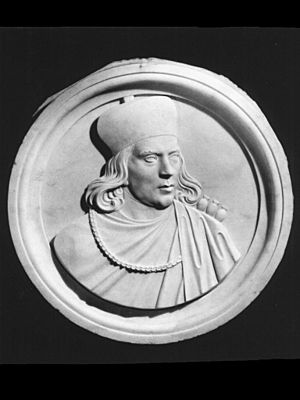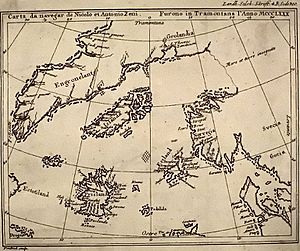Voyage of the Zeno brothers facts for kids
The Zeno brothers, Nicolò (c. 1326 – c. 1402) and Antonio (died c. 1403), were Italian noblemen from the Republic of Venice who lived during the 14th century. They came to prominence in 1558, when their descendant, Nicolò Zeno the Younger, published a map and a series of letters purporting to describe an exploration made by the brothers of the north Atlantic and Arctic waters in the 1390s. The younger Nicolò claimed the documents were discovered in a storeroom of his family home.
Widely accepted at the time of publication, the map was incorporated into the works of leading cartographers, including Gerardus Mercator. Modern historians and geographers have disputed the veracity of the map and the described voyages, with some accusing the younger Zeno of forgery.
Nicolò and Antonio were brothers of the Venetian naval hero Carlo Zeno. The Zeno family was an established part of the aristocracy of Venice and held the franchise for transportation between Venice and the Holy Land during the Crusades. According to the younger Zeno, the map and letters date from around the year 1400 and describe a long voyage made by the Zeno brothers in the 1390s under the direction of a prince named Zichmni. Supporters of a legend involving the contemporaneous Scottish nobleman Henry Sinclair, Earl of Orkney suggest that Zichmni is a mistranscription of d’Orkney. The voyage supposedly traversed the North Atlantic and, according to some interpretations, reached North America nearly a century before the voyages of Christopher Columbus.
Contents
Alleged voyage
Nicolò and Antonio are notable for a number of letters and a map (the so-called "Zeno map") published in the year 1558 by one of their descendants, also named Nicolò Zeno. This descendant was a historian who has published other works on the history of Venice. The letters, allegedly written by the brothers around 1400, describe a voyage of exploration that they say they undertook throughout the North Atlantic (and, by some interpretations, to North America) under the command of a prince named Zichmni (whom some have identified as Henry Sinclair). Some commentators have suggested that a descendant, William Sinclair (c. 1404 – c. 1484), the builder of Rosslyn Chapel, had knowledge of Henry Sinclair's involvement with the Zeno brothers and had decorated the interior of the chapel with carvings of plants discovered during the voyage. This claim of "proof" that the voyage took place has been discredited.
The letters and accompanying map are controversial and are regarded by at least one historian as a hoax, perpetrated either by the Zeno brothers themselves or by their descendant who wrote a narrative which he said was based on what was left of letters that he had torn up as a boy. In 1989, Italian scholar Giorgio Padoan published a study suggesting that there is some authenticity in their travels and that Nicolò is not to be found in any document between the years 1396–1400 (so he could have been at least in Iceland), while Andrea Di Robilant has written a book on this possibility.
The letters
The letters are divided into two parts. The first set contains letters from Nicolò to Antonio. The second consists of letters from Antonio to their brother Carlo.
The first letters (from Nicolò to Antonio) tell how Nicolò set off in 1380 on a voyage from Venice to England and Flanders. Evidence exists that such a voyage took place, and that Nicolò returned to Venice around 1385.
In the letters, Nicolò describes being stranded on an island between Great Britain and Iceland called Frislanda, which is described as being larger in size than Ireland. By chance Nicolò is rescued by Zichmni, who is described as a prince who owned some islands called Porlanda off the southern coast of Frislanda, and who ruled the duchy of Sorant, or Sorand, southeast of Frislanda. It has been suggested that Frislanda is in fact a stand-in for the Faroe Islands, with individual islands mistakenly merged into a single landmass by Nicolò the younger, although Frisland and the Faroe Islands appear together on several maps, many hundreds of miles apart.
Nicolò invites Antonio to come to Frislanda with him, which he does, staying for fourteen years. Under Zichmni's direction, Antonio attacks "Estlanda" (ostensibly the Shetland Islands, as indicated by similarities between placenames mentioned in the letters). Zichmni then attempts to attack Iceland. After finding it too well-defended, he attacks seven islands along its eastern side: Bres, Talas, Broas, Iscant, Trans, Mimant, and Damberc. All of these islands are fictitious. An alternative interpretation finds that in transcribing the letters the Zeno brothers' descendant mistook a reference to "Estlanda" for "Islanda" or Iceland, thus accounting for both the presence of those superfluous islands off Iceland and the mysterious absence of an equal number of islands off of the Shetland Islands. Further evidence in support of this claim is the similarity of placenames in the Zenos' "Islanda" to placenames in modern‐day Shetland, for instance the island of Bressay for "Bres", and Danaberg sound near Lerwick for "Damberc".
Zichmni then builds a fort on Bres and leaves Nicolò in charge of it. Nicolò makes a voyage to Greenland and finds a monastery with central heating. According to the alternative interpretation cited above, in which the travellers had yet to leave Estlanda, the subsequent destination is in fact Iceland, explaining the presence of geothermal heating and other observations.
Zichmni receives word that a group of lost fishermen from Frislanda have returned after an absence of over twenty-five years. The fishermen describe making landfall in the far west in unknown countries called Estotiland and Drogeo. They claim to have encountered strange animals as well as cannibals, from whom they escaped only after teaching them how to fish. Inspired by the tales of the fishermen, Zichmni undertakes a voyage to the west with Antonio in charge of his fleet. To the west of Frislanda (see the Zeno map), they encounter a large island called Icaria, which does not exist.
According to the letters, the inhabitants of Icaria greet them before they can make landfall. Only one person among the Icarians is able to speak a language that Zichmni understands. The inhabitants state that visitors to the island are not welcome and that they will defend the island to the last man if need be. Zichmni sails along the island looking for a place to make landfall, but the inhabitants chase him and Zichmni abandons the effort.
Sailing west, they make landfall at a promontory called Trin on the southern tip of "Engrouelanda". Zichmni likes the climate and the soil, but his crew find it inhospitable. The sailors return home with Antonio, while Zichmni stays on to explore the area and build a town.
The map
Phantom islands
Estotiland
"Estotiland" appears on the Zeno map ostensibly on the western side of the Atlantic Ocean, in the approximate location of what is now known to be Labrador, on the northeast coast of North America. Estotiland is listed along with Eden and Arcadia under the heading "utopia, paradise, heaven, heaven on earth" in Roget's International Thesaurus. It is one of the sources for the Russian "Estoty", featured in Vladimir Nabokov's Ada.
Frisland
"Frisland" appeared on virtually all maps of the North Atlantic from the 1560s to the 1660s. It is not to be confused with the similarly named Friesland in the Netherlands, nor the two Frieslands (East and North) in Germany. The placename originally referred to Iceland ("Freezeland"), but after the Zeno map placed it as an entirely separate island south (or occasionally southwest) of Iceland, it appeared that way on maps for the next 100 years.
Other islands
"Islanda" is clearly Iceland. "Estland" is presumed to be Shetland, with various placenames recognisable as belonging to that island group. It has been tentatively suggested that "Podalida" is a corruption of Pomona, a historical name for Mainland, Orkney. "Icaria", or "Caria" if the initial "I" means "Island", has been suggested as a misplaced Kerry or Kilda, but may simply be an invention of the mapmaker. "Neome" has been identified as Fair Isle or Foula.
See also
 In Spanish: Hermanos Zeno para niños
In Spanish: Hermanos Zeno para niños



